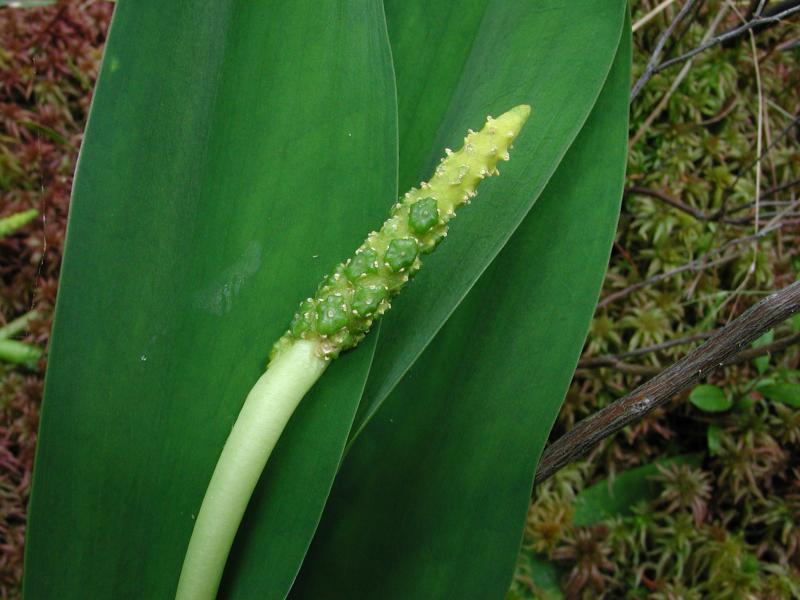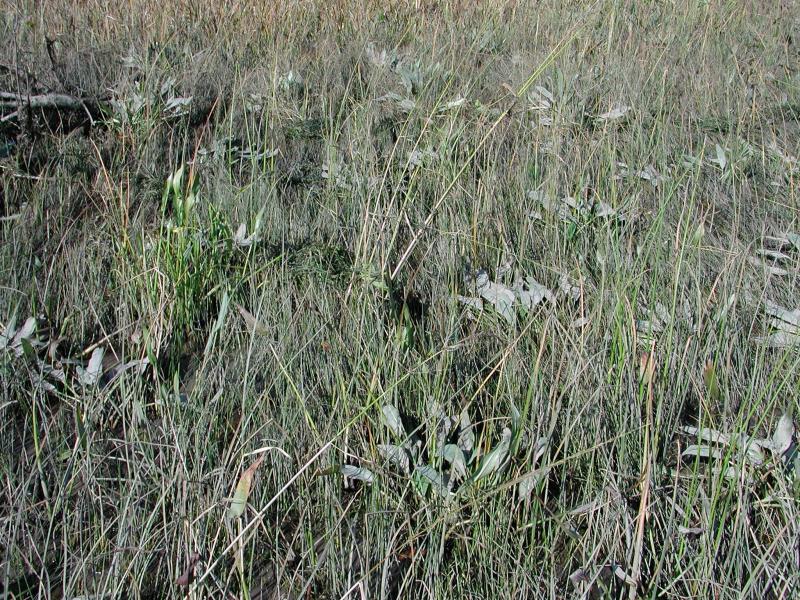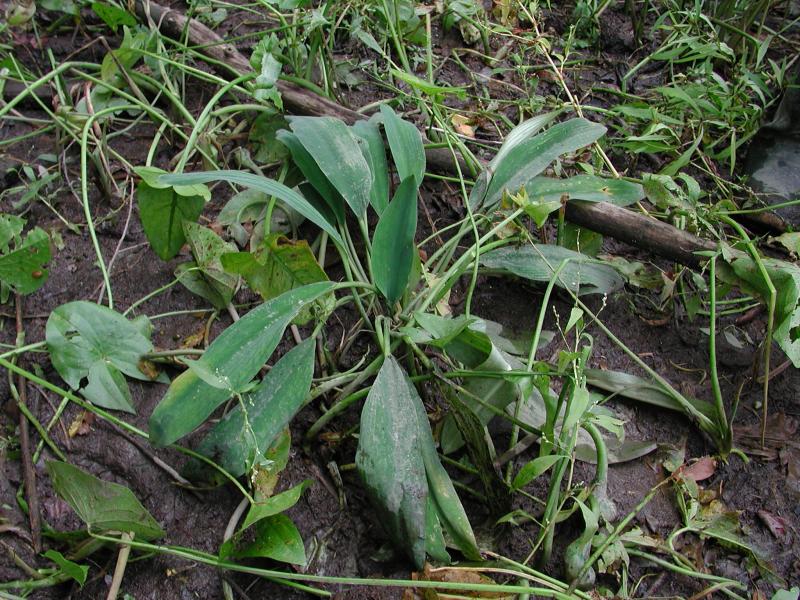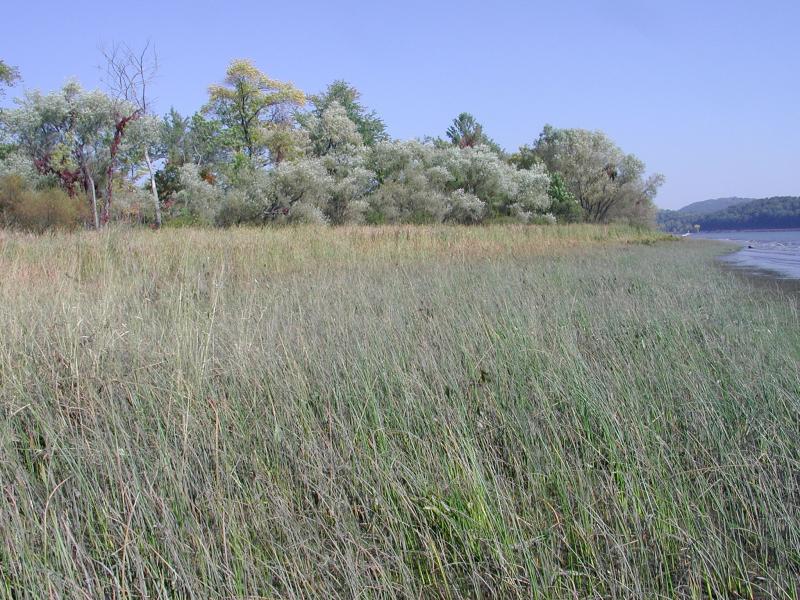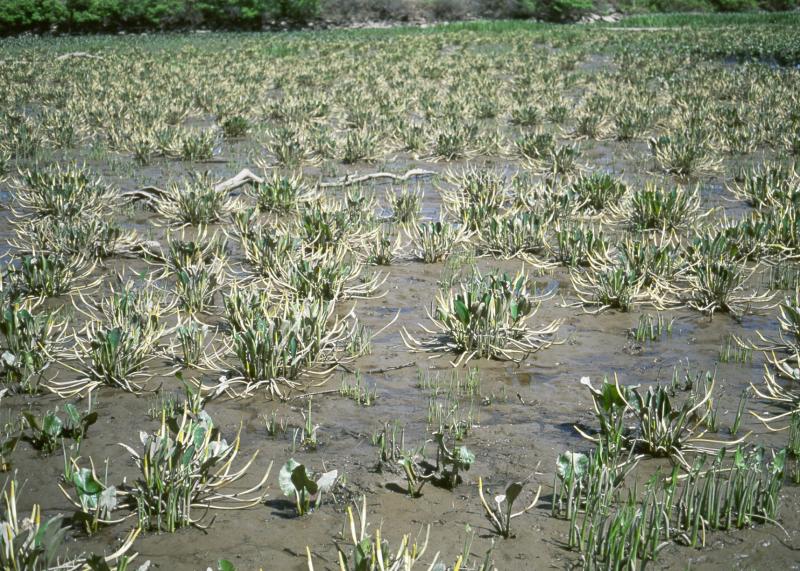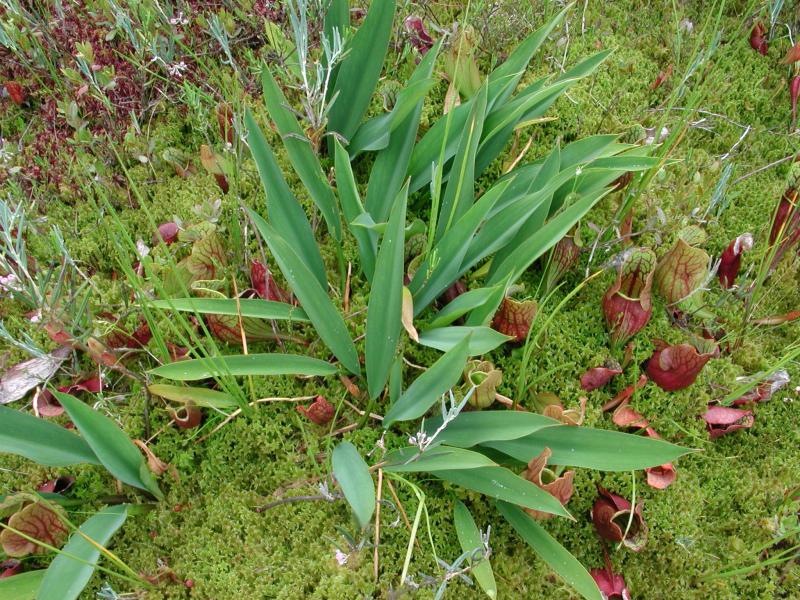Golden Club
Orontium aquaticum L.
- Class
- Monocotyledoneae (Monocots)
- Family
- Araceae (Arum Family)
- State Protection
- Threatened
Listed as Threatened by New York State: likely to become Endangered in the foreseeable future. For animals, taking, importation, transportation, or possession is prohibited, except under license or permit. For plants, removal or damage without the consent of the landowner is prohibited.
- Federal Protection
- Not Listed
- State Conservation Status Rank
- S2
Imperiled in New York - Very vulnerable to disappearing from New York due to rarity or other factors; typically 6 to 20 populations or locations in New York, very few individuals, very restricted range, few remaining acres (or miles of stream), and/or steep declines.
- Global Conservation Status Rank
- G5
Secure globally - Common in the world; widespread and abundant (but may be rare in some parts of its range).
Summary
Did you know?
Golden club really has a split personality when it comes to habitats. It occurs in two very different wetland habitats in New York; in freshwater intertidal mud flats and marshes and also in the peat moss of a few shrub bogs. This is the only species in the genus and, unlike the related jack-in-the-pulpit, this genus has only a Jack and no pulpit! The starch in the rhizomes and seeds is edible once it is boiled (Mabberley 1987).
State Ranking Justification
There are 13 existing populations but only two of these are in Sphagnum bogs and not in freshwater tidal areas. About half of the populations are in good to excellent condition. There are seven historical records from Long Island that are probably extirpated.
Short-term Trends
Short-term trends are good as existing populations have not seen a decline over the last 20 years.
Long-term Trends
There has been a decline in populations on Long Island as the area has been developed but most of the historical records from the 20th-century continue to exist today along with some new discoveries.
Conservation and Management
Threats
Hudson river populations are threatened by the spread of Phragmites and water chestnut and by the erosive power of boat wakes. Some bog populations may be threatened by too much visitation.
Conservation Strategies and Management Practices
Establish sufficient buffers around populations to preserve the undisturbed aspect and hydrology of their habitat.
Research Needs
Research is needed to determine why some populations occur in the completely different habitat of Sphagnum bogs while most of the populations occur in freshwater tidal areas of the Hudson River. Habitat parameters should also be determined for the bog populations to understand why this species does not occur in similar habitat in other areas of the state.
Habitat
Habitat
Most known existing sites for Golden Club in New York State are freshwater tidal marshes, swamps, and mudflats. However this species is also found in other quite different Sphagnum-dominated habitats in the state (and elsewhere), such as bogs, poor fens, and coastal plain ponds. Golden Club apparently is tolerant of a wide range of acidity and exposure to light, though all of the sites it is known from are habitats of still, shallow water (New York Natural Heritage Program 2007). Sandy, muddy or peaty shores and shallow water (Fernald 1970). Swamps and shallow water, especially on the coastal plain (Gleason & Cronquist 1991).
Associated Ecological Communities
- Coastal plain pond*
(guide)
The aquatic community of the permanently flooded portion of a coastal plain pond with seasonally, and annually fluctuating water levels. These are shallow, groundwater-fed ponds that occur in kettle-holes or shallow depressions in the outwash plains south of the terminal moraines of Long Island, and New England. A series of coastal plain ponds are often hydrologically connected, either by groundwater, or sometimes by surface flow in a small coastal plain stream.
- Freshwater intertidal mudflats
(guide)
A sparsely vegetated community characterized by low rosette-leaved aquatics. This community occurs on exposed intertidal mudflats where the water is fresh (salinity less than 0.5 ppt). This community is best developed where mudflats are nearly level so that broad expanses are exposed at low tide. The plants are completely submerged in 0.9 to 1.2 m (3 to 4 ft) of water at high tide and they are usually coated with mud.
- Freshwater intertidal shore
(guide)
A community of the intertidal gravelly or rocky shores of freshwater tidal rivers and creeks, sometimes occurring at the base of cliffs. The vegetation may be very sparse.
- Freshwater tidal creek*
(guide)
The aquatic community of a shallow, tidally flooded freshwater creek with submerged areas averaging less than 2 m (6 ft) deep at low tide.
- Freshwater tidal marsh
(guide)
A marsh community that occurs in shallow bays, shoals, and at the mouth of tributaries of large tidal river systems, where the water is usually fresh (salinity less than 0.5 ppt), and less than 2 m (6 ft) deep at high tide. Typically there are two zones in a freshwater tidal marsh: a low-elevation area dominated by short, broadleaf emergents bordering mudflats or open water, and a slightly higher-elevation area dominated by tall grass-like plants.
- Inland poor fen
(guide)
A wetland fed by acidic water from springs and seeps. Plant remains in these fens do not decompose rapidly and thus the plants in these fens usually grow on older, undecomposed plant parts of mostly sphagnum mosses.
* probable association but not confirmed.
Associated Species
- Acorus americanus (American sweet-flag)
- Amaranthus cannabinus (salt marsh water-hemp)
- Andromeda polifolia
- Boehmeria cylindrica (false nettle)
- Callitriche palustris (vernal water-starwort)
- Caltha palustris (marsh-marigold)
- Carex pauciflora (few-flowered sedge)
- Chamaedaphne calyculata (leatherleaf)
- Chelone glabra (white turtle-head)
- Clethra alnifolia (coastal sweet-pepperbush)
- Drosera rotundifolia (round-leaved sundew)
- Eriophorum virginicum (tawny cotton-grass)
- Heteranthera dubia (water star-grass)
- Impatiens capensis (spotted jewelweed, spotted touch-me-not)
- Iris pseudacorus (yellow iris)
- Kalmia polifolia (bog laurel)
- Lythrum salicaria (purple loosestrife)
- Mimulus ringens (Allegheny monkey-flower)
- Myriophyllum aquaticum (parrot's-feather)
- Nuphar advena
- Osmunda cinnamomea
- Peltandra virginica (green arrow-arum, tuckahoe)
- Persicaria punctata (dotted smartweed)
- Pilea fontana (black-fruited clearweed)
- Pilea pumila
- Pontederia cordata (pickerelweed)
- Rhynchospora alba (white beak sedge)
- Sagittaria latifolia (common arrowhead)
- Sagittaria montevidensis
- Sagittaria subulata (awl-leaved arrowhead)
- Salix
- Sarracenia purpurea (purple pitcherplant)
- Scheuchzeria palustris (pod-grass)
- Schoenoplectus americanus (chair-maker's bulrush)
- Sphagnum magellanicum
- Stachys
- Symplocarpus foetidus (skunk-cabbage)
- Trapa natans (water-chestnut)
- Typha latifolia (wide-leaved cat-tail)
- Vallisneria
- Zizania aquatica
Range
New York State Distribution
Most of the currently extant populations of Golden Club are located in the freshwater tidal areas of the Hudson River, but there are also known extant populations in central New York, and north-central Long Island, and many historical populations from inland within the Hudson Valley and the Long Island and New York City areas.
Global Distribution
Golden Club reaches its northern limit in New York and Massachusetts, and is found mainly along the coast south to Florida and west to Texas, but also inland to Tennessee, Kentucky, West Virginia, and Pennsylvania.
Identification Comments
General Description
Orontium aquaticum is a perennial, rooted aquatic plant growing from stout rhizomes. It has spreading (sometimes reclining or floating), strap-like (6-20 cm long and a third as wide), basal leaves only, these are also parallel-veined. The many bright yellow flowers are borne on the upper portion (2-5 cm) of a single fleshy, erect white stalk (the spadix) 20-40 cm tall.
Similar Species
Orontium aquaticum looks like nothing else in our state.
Best Time to See
Golden Club flowers from mid-April through June, with vegetative leaves and fruits persisting until first frost.
- Vegetative
- Flowering
- Fruiting
The time of year you would expect to find Golden Club vegetative, flowering, and fruiting in New York.
Golden Club Images
Taxonomy
Golden Club
Orontium aquaticum L.
- Kingdom Plantae
- Phylum Anthophyta
- Class Monocotyledoneae
(Monocots)
- Order Arales
- Family Araceae (Arum Family)
- Order Arales
- Class Monocotyledoneae
(Monocots)
- Phylum Anthophyta
Additional Resources
Best Identification Reference
Gleason, Henry A. and A. Cronquist. 1991. Manual of Vascular Plants of Northeastern United States and Adjacent Canada. The New York Botanical Garden, Bronx, New York. 910 pp.
Other References
Clemants, Steven and Carol Gracie. 2006. Wildflowers in the Field and Forest. A Field Guide to the Northeastern United States. Oxford University Press, New York, NY. 445 pp.
Crow, Garrett E. and C. Barre Hellquist. 2000. Aquatic and wetland plants of northeastern North America: A revised and enlarged edition or Norman C. Fassett's a manual of aquatic plants. Volume two angiosperms: Monocotyledons. The University of Wisconsin Press. Madison, Wisconsin. 456 pp.
Fernald, M.L. 1950. Gray's manual of botany. 8th edition. D. Van Nostrand, New York. 1632 pp.
Flora of North America Editorial Committee. 2000. Flora of North America north of Mexico. Vol. 22. Magnoliophyta: Alismatidae, Arecidae, Commelinidae (in part), and Zingiberidae. Oxford Univ. Press, New York. xxiii + 352 pp.
Holmgren, Noel. 1998. The Illustrated Companion to Gleason and Cronquist's Manual. Illustrations of the Vascular Plants of Northeastern United States and Adjacent Canada. The New York Botanical Garden, Bronx, New York.
New York Natural Heritage Program. 2010. Biotics database. New York Natural Heritage Program. New York State Department of Environmental Conservation. Albany, NY.
New York Natural Heritage Program. 2024. New York Natural Heritage Program Databases. Albany, NY.
Newcomb, Lawrence. 1977. Newcomb's Wildflower Guide: An Ingenious New Key System for Quick, Positive Field Identification of the Wildflowers, Flowering Shrubs, and Vines of Northeastern and North-Central North America. Little, Brown and Company. Boston.
Rhoads, Ann F. and Timothy A. Block. 2000. The Plants of Pennsylvania, an Illustrated Manual. University of Pennsylvania Press, Philadelphia, PA.
Weldy, T. and D. Werier. 2010. New York flora atlas. [S.M. Landry, K.N. Campbell, and L.D. Mabe (original application development), Florida Center for Community Design and Research http://www.fccdr.usf.edu/. University of South Florida http://www.usf.edu/]. New York Flora Association http://newyork.plantatlas.usf.edu/, Albany, New York
Weldy, Troy W. and David Werier. 2005. New York Flora Atlas. [S.M. Landry, K.N. Campbell, and L.D. Mabe (original application development), Florida Center for Community Design and Research. University of South Florida]. New York Flora Association, Albany, NY. Available on the web at (http://newyork.plantatlas.usf.edu/).
Links
About This Guide
Information for this guide was last updated on: January 5, 2009
Please cite this page as:
New York Natural Heritage Program. 2024.
Online Conservation Guide for
Orontium aquaticum.
Available from: https://guides.nynhp.org/golden-club/.
Accessed July 26, 2024.
